

Memristor basic performance test solution based on precise source measure unit (SMU)
Focus on semiconductor electrical performance testing
Position:Home > Solutions > Semiconductor discrete devices
Based on classical circuit theory, there are four basic circuit physical quantities, namely current (i), voltage (v), charge (q) and magnetic flux (o). According to these four basic physical quantities, six mathematical relationships can be deduced theoretically, and three basic circuit components (resistance R, capacitance C, and inductance L) can be defined at the same time. In 1971, Professor Cai Shaotang proposed the fourth basic circuit element-Memristor based on the theoretical derivation of the relationship between the four basic electrical physical quantities voltage, current, charge and magnetic flux, which represents the magnetic flux and charge interrelationships between.
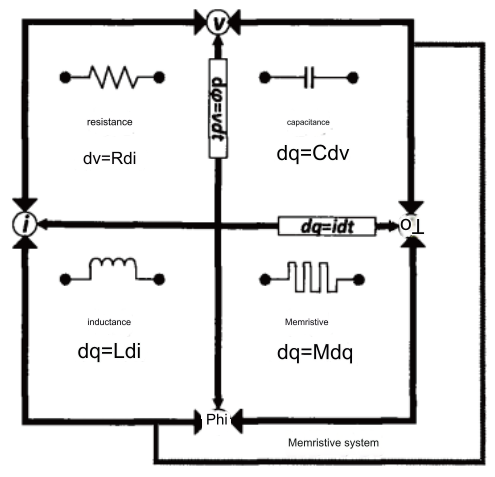
Relationship among four passive components and among four electrical variables
Structural properties of memristors
A memristor is a two-terminal device with a simple Metal/Di-electric/Metal "sandwich" structure, as shown in the figure below, generally consisting of a top electrode, an insulating dielectric layer, and a bottom electrode. The upper and lower metal layers are used as electrodes, the upper metal is used as the top electrode, and the lower metal is used as the bottom electrode. The metal is usually a traditional metal element, such as Ni, Cu, etc., and the middle dielectric layer is usually composed of binary transition metal oxides, such as HfO2 , WOx, etc., can also be composed of materials with complex structures, such as IGzO, etc. These media generally have high impedance.
Its expression formula is d=M(q)d q, where M(q) is the memristor value, indicating the rate of change of magnetic flux () with accumulated charge (q), which has the same dimension as resistance. The difference is that the internal physical state of the ordinary resistor does not change, and its resistance value usually remains unchanged, while the resistance value of the memristor is not a fixed value, it has a certain relationship with the magnetic flux and current, and after the electric excitation stops, its resistance The value will not return to the initial value, but stay at the previous value, that is, it has the characteristic of "memristive".
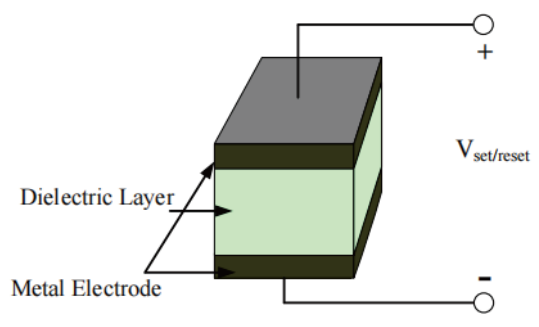
Internal diagram of memristor structure
Resistance switching mechanism and material properties of memristor
Memristor devices have two typical resistance states, namely high resistance state (HRS) and low resistance state (LRS). Lower resistance, usually hundreds of Ω. Initially, without any electrical excitation, the memristive device is in a high-resistance state, and its resistance state will switch between two resistance states under electrical excitation. For a new memristive device, before switching between high and low resistance states, it needs to undergo an electrical activation process. This process usually has a large voltage, and in order to prevent the device from being broken down, the current needs to be limited. The transition of a memristor from a high resistance state to a low resistance state is a set (SET) process, and the transition from a low resistance state to a high resistance state is a reset (RESET) process. When the polarity of the voltage applied in the SET process and the RESET process is the same, it is called unipolar resistive switching behavior, and when the polarity of the voltage applied in the SET process and RESET process is different, it is called bipolar resistive switching behavior.
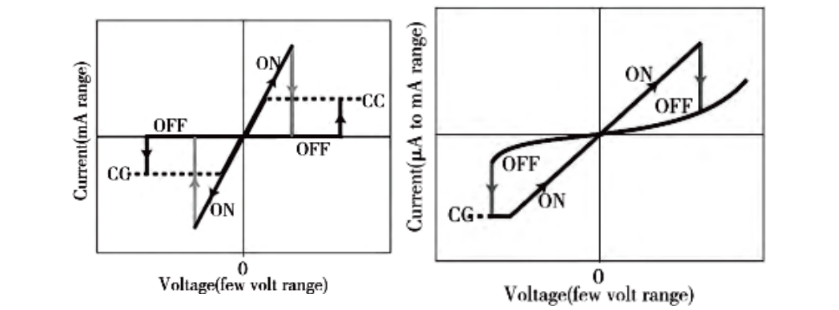
Unipolar resistive switching behavior and bipolar resistive switching behavior
The selection of memristive materials is an extremely important step in the construction of memristive devices. The material system usually includes dielectric layer materials and electrode materials. Different combinations of the two can make memristors have different resistance switching mechanisms and properties. Since the HP laboratory proposed the TiO2-based memristor model, more and more new materials have been found suitable for memristors, mainly including organic materials, oxide materials, chalcogenide materials and electrode materials with different activities.
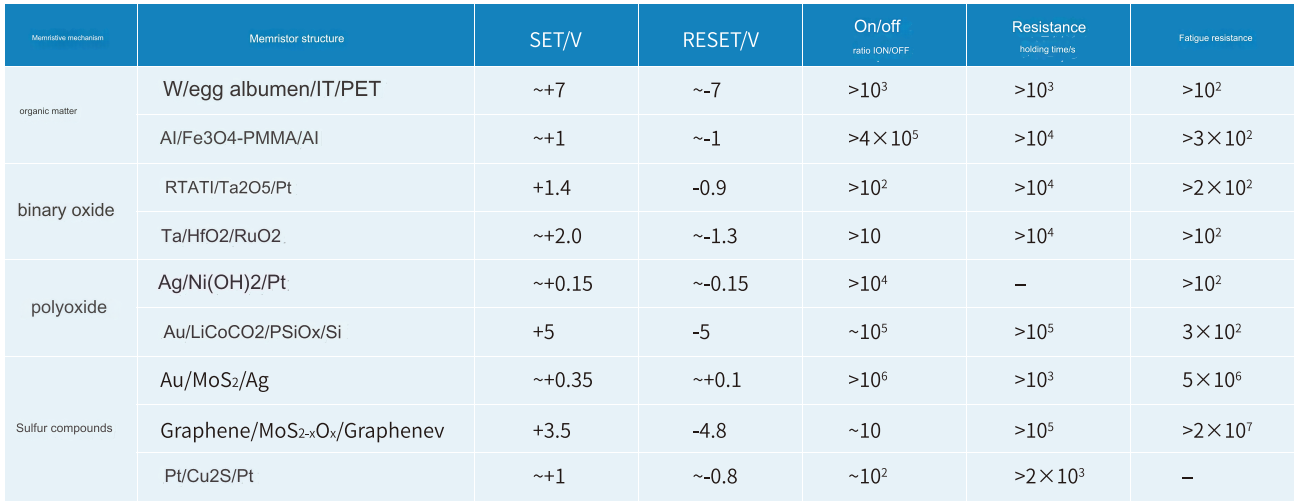
Comparison of typical performance parameters of different dielectric material memristors
At present, metals that can be used as memristor electrode materials are generally divided into two categories: one is metal materials, including active metals such as Cu, Ag, Ru, etc., and inert metals such as Pt, Pd, Au, W, etc.; the other is compound materials. Materials, including oxides SrRuO3, LaAlO3, ITO, IZO, etc., nitrides TaN, TiN, etc. Memristors assembled based on different electrode materials often have different resistive switching mechanisms and electrochemical properties.

As a kind of resistive switch, the size of memristor can be reduced to less than 2nm, the switching speed can be controlled within 1ns, the number of switching can be more than 2×107, and it also has lower operating power consumption than existing electronic components. Memristor has many advantages such as simple Metal/Dielectric/Metal structure, low working voltage, and compatibility with traditional CMOS technology. It has been applied in many fields, and can be used in digital circuits, analog circuits, artificial intelligence and neural networks, It plays an important role in many fields such as memory. The high and low resistance values of the device can be used to represent "0" or "1" in binary, the switching time of different resistance states is as small as nanoseconds, the low operating voltage leads to low power consumption, and compared with the MOS structure, it is not affected by Due to the limited feature size, it is very suitable as a high-density memory, so memristors are also commonly called resistive RAM (RRAM).
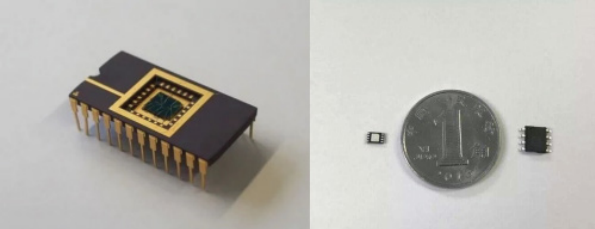
Typical Memristor Picture
Current-Voltage Characteristics and Classification of Memristors
The resistance switching behavior of memristor is mainly reflected in its I-V curve. Memristor devices made of different materials have differences in many details. According to the change of resistance value with the change of applied voltage or current, it can be divided into There are two types, namely linear memristor LM (linear memristor) and nonlinear memristor NLM (non-linear memristor).
The voltage or current of the linear memristor does not change abruptly, that is, its resistance value changes continuously with the change of the external electrical signal. Linear memristors are all bipolar devices, that is, when the input electrical signal is positive, the resistance decreases, and when the input electrical signal is negative, the resistance increases.
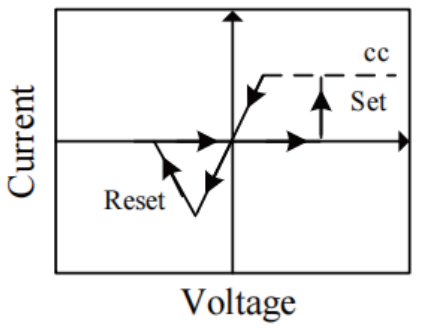
Memristor Basic Performance Research Test
The evaluation of memristive devices generally includes testing of DC characteristics, pulse characteristics and AC characteristics, analyzing the memristive characteristics of the device under the corresponding DC, pulse and AC effects, and non-electrical characteristics such as retention and stability of the memristive device. Take measurements. The general main tests are shown in the table below.
DC l-V characteristic test
Different polarities and different magnitudes of voltage (current) excitation will cause a certain change in the resistance of the memristor, and the DC l-V characteristics directly reflect the change of the resistance value of the device under different voltage (current) excitations, which is a characteristic of the electrical characteristics of the device. basic means. Through the test curve of the DC characteristic, the resistive switching characteristic and the threshold voltage/current characteristic of the memristor device can be preliminarily studied, and its l-V, R-V and other characteristic curves can be observed.
AC l-V and C-V characteristic test
Since the resistance value of an ideal memristor changes with the amount of charge flowing through it, the traditional DC I-V scan uses a stepped signal for output testing. Therefore, the l-V curve obtained by the traditional DC scan cannot truly reflect the characteristics of the memristor.
Pulse characteristics and retention test
The pulse characteristics of the memristor specifically include testing the multi-resistance characteristics of the test sample, the resistance state switching rate and switching amplitude, and the resistance state switching durability and other performance tests.
The multi-resistance characteristics characterize the multi-resistance characteristics of memristors in different operating modes, and directly reflect the nonlinear resistance characteristics of memristors. The switching rate and switching amplitude of the resistance state represent the difficulty of switching the memristor in different resistance states. Keeping the amplitude of the excitation pulse constant, the smaller the minimum pulse width that can change the resistance state of the memristor, the higher the resistance of the memristor. The higher the state switching rate is, the lower it is vice versa; keeping the excitation pulse width constant, the lower the minimum pulse amplitude that can change the resistance state of the memristor, the easier it is to change the resistance of the memristor. Resistance switching durability, by selecting a suitable pulse, measuring the number of times the resistance state of the memristor is switched back and forth under the action of the pulse. This parameter reflects the resistance switching stability of the device.
Memristor Basic Performance Test Solution
The whole set of test system is based on Proces S/P/CP series high-precision digital source measure meter (SMU), with probe station, low-frequency signal generator, oscilloscope and special host computer software, etc., can be used for memristor basic parameter test, medium High-speed pulse performance test, AC characteristic test, suitable for research on new material systems and special network physical mechanisms.
Precise high-precision digital source measure unit (SMU) plays an extremely important role in the measurement and characterization of semiconductor characteristics. It has higher precision than ordinary ammeter and voltmeter, and has extremely high sensitivity in testing weak voltage and small current signals. In addition, with the increasing requirements for sensitivity, speed, remote voltage detection and four-quadrant output in the measurement process, traditional programmable power supplies are not up to the task. PRECISE S/P/CP series high-precision digital source measure unit (SMU) is used for memristor as excitation source to generate voltage or current scanning test signal, and real-time test the current or voltage feedback value corresponding to the sample, combined with special test software, It can output DC or pulse l-V characteristic curve in real time.
S series high precision DC source measure meter
The S series source measure meter is the first localized source measure meter with high precision, large dynamic range and digital touch that Pusis has built for many years. It integrates various functions such as input and output of voltage and current, and measurement. The maximum voltage is 300V, and the maximum current is 1A. It supports four-quadrant operation and is suitable for DC l-V characteristic testing in the research and testing phase of memristors.
P series high precision pulse source measure meter
The Р series pulse source measure meter is a new high-precision, large dynamic, digital touch source measure unit based on the DC source measure unit. It integrates various functions such as voltage, current input, output and measurement. Pulse output current up to 10A, supports four-quadrant operation.
CP series pulse constant voltage source
Precise CP series pulse constant voltage source is a narrow pulse width, high precision, wide range plug-in card type pulse constant voltage source launched by Wuhan Precise Instruments. The device supports narrow pulse voltage output, and simultaneously completes the output voltage and current measurement; supports multi-device triggering to realize pulse l-V scanning of devices, etc.; supports output pulse timing adjustment, and can output complex curves. Its main features are: large pulse current, up to 10A; narrow pulse width, down to 100ns; support DC and pulse voltage output modes; support linear, logarithmic, and custom multiple scanning working modes. The product can be applied to memristor and material research and testing.
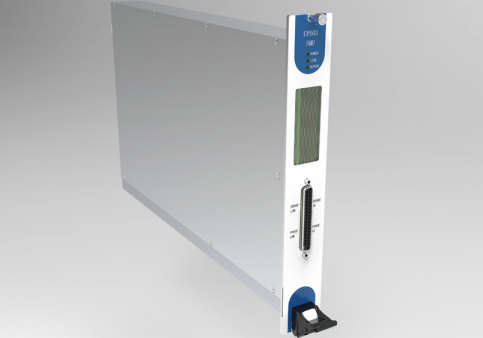
Wuhan Precise has been focusing on the development of electrical performance test instruments and systems in the field of power devices, radio frequency devices, memristors, and third-generation semiconductors. Type source measure meters, pulse large current sources, high-speed data acquisition cards, pulse constant voltage sources and other instrument products, as well as a complete set of test systems. Products are widely used in scientific research and testing of various cutting-edge materials and devices. Precise provides a variety of different configuration schemes to meet different customer needs.